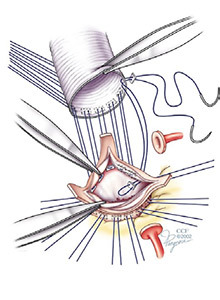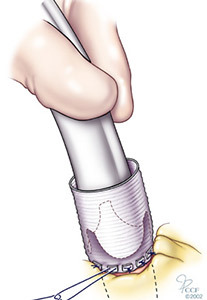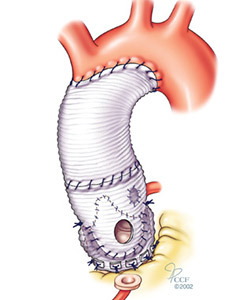What is valve-sparing aortic root reimplantation/replacement surgery?
Valve-sparing aortic root reimplantation/replacement surgery is a treatment option for some patients who have an aneurysm that affects the aortic root. This treatment involves keeping your own aortic valve intact, unless it is too damaged, in which case a replacement valve (tissue or mechanical) is used.
The procedure helps reduce the risk of stroke and an infection in the heart called endocarditis. Patients who have the procedure completed with their own valve or tissue valve do not need to take blood thinners for the rest of their lives, as they do if the valve is replaced with an artificial, mechanical valve.
What is the aortic root?
The aortic root is the part of the aorta that is attached to your heart. The aortic root includes a tough, fibrous ring (annulus), tissue flaps in the valve (leaflets) and the openings that lead to the coronary arteries (coronary ostia).
How is the surgery done?
Valve-sparing aortic root replacement surgery is done using a traditional chest incision.

- You will get general anesthesia to put you to sleep.
- Your surgeon will cut your aorta just above the aortic valve annulus and coronary ostia, then take out the section of aorta with the aneurysm.
- Sutures are put in place below your aortic valve, around the left ventricular outflow tract (LVOT) (section of your heart’s
bottom left chamber that connects to
your aorta), and also through the graft.

- The removed section of aorta is replaced with a polyester graft coated with collagen.
- A special piece of equipment, called a Hegar’s dilator, is placed in the LVOT through your aortic valve.
- The sutures are then tied around the dilator to shape the bottom part of the graft so it is similar to your natural aortic root.

- Your aortic valve is put in place (reimplanted) inside the graft. Your surgeon will test the valve to make sure it opens and closes as it should and does not leak.
- Your surgeon will make small holes in the graft to connect the coronary arteries.
- The graft is then attached to your aorta. If you also need an aortic arch replacement, a separate graft is sewn into place
between the aortic arch and aortic root.
Who can have this surgery?
You may be able to have this surgery if:
- You have an enlarged aortic root that involves your aortic valve.
- Your aortic valve is not narrow or stiff (calcified), badly torn, prolapsed or leaking.
How long will I be in the hospital?
Plan to stay in the hospital 4 to 7 days. You will spend 1 to 2 days in the cardiovascular intensive care unit (CVICU) and another 4 to 5 days in a stepdown unit. You will get detailed information about your surgery and recovery after the procedure is scheduled.
What type of follow-up will I need?
You will get a detailed follow-up schedule after your surgery. In general, expect to have regular visits and a yearly echocardiogram to check your aorta and aortic valve.
Your surgeon may recommend that you complete an outpatient cardiac rehab program as part of your recovery and to improve your cardiovascular health. Cardiac rehab specialists will work with you to create a personal plan that includes education, exercise, nutrition and support.
How successful is this surgery?
Cleveland Clinic surgeons are highly skilled at performing valve-sparing aortic root reimplantation/replacement surgery. Based on 1,200 procedures, the survival rate for patients who chose to have this surgery was 99.5%, and 95% of patients did not need a repeat procedure within 10 years. Your surgeon will talk to you about your individual risks and benefits.